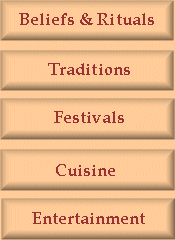


Food is a major part of Bengali culture. The Bengali’s love for food is legendary. It probably has its roots in the soil and water of the state which is rich in possibilities.
While the Bengal soil bursts forth with a variety of vegetables, herbs and vines,the
water bodies teem with the choicest fish and crustaceans that end up on the 'thalas' of the Bengali household. Bengali cuisine takes in the five basic tastes of astringent, bitter, sweet, sour and hot. Bengalis are, on the whole, an infectiously passionate lot and few things unite them more than their common passion for food—especially for fish. No meal is considered complete without it. Symbols of fertility, fish are touched by husbands and then sent to their brides before the wedding ceremony.
Fish heads are put into pots of split peas to add peas richness and flavor; tiny shrimp are stir-fried with vegetables; fish are steamed, fried, smoked, made into balls and patties, even stuffed into creamy green coconuts and baked. But, just as the Bengali- however westernized—never gave up his language, neither did he give up his Bengali food and his passion fish, rice—and sweets. No Bengali meal is complete without sweets. From the ubiquitous mishti doi and rossogolla, to the more rare pithey and pulli, the choice here too is unlimited.
In fact, Bengalis have, with justification, such high regard for their food that it is usually heard that there are only four great cuisines in the world—French, Chinese, Italian and Bengali!! Even though Bengalis are famed for their fish fixation, the array of vegetarian items that form part of their cuisine is amazing.
It is said that nothing goes to waste in a Bengali kitchen. The leaves of the banana plant are used for serving, the stems (thor) are cooked as ghonto or chhechhki, the blossoms (mocha) are also consumes as ghonto and paturi (a way of cooking food wrapped in banana leaves). The fruit is available both in the ripe and raw form, the latter being considered ideal for koftas. And what do you know, even the peel is crushed and ground to a paste and fried for a delicious starter!
Whether you have five dishes or sixty, the most important part of eating in Bengal is eating each dish seperately with a little bit of rice in order to savour its individual bouquet. The more delicate tastes always come first and it is only by graduating from these to stronger ones that you can accommodate the whole range of taste.
Vegetables, especially the bitter ones, are the first item followed by dal, perhaps accompanied by fries or fritters of fish and vegetables. After this comes any of the complex vegetable dishes like ghanto or chachchari, followed by the important fish jhol as well as other fish preparations. Meat will always follow fish, and chutneys and ambals will provide the refeshing touch of tartness to make the tongue anticipate the sweet dishes.
Whether having an elaborate meal at home, or tucking in at a restaurant, Bengali cuisine has much to offer. Small wonder then that it is that said Bengalis live to eat. Some of the most popular recipes are Matha Diye Moonger Dal, Narkel Shorsher Chingri, Doi Maachh, Potoler Dolma, Labra, Shukto, Ghugni, Cholar-daal, Oal kochu bata, Chingri maachher malai kari, Dhokar dalna, Alu posto, Bhapa Ilish, Deemer-dalna, and among the sweetmeats, Patishapta, Chaaler Payesh, Rosogulla and Bhappa Doi, to name a few.
